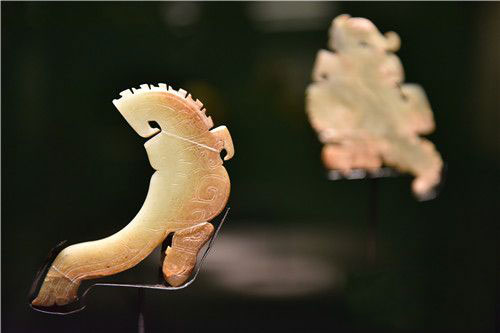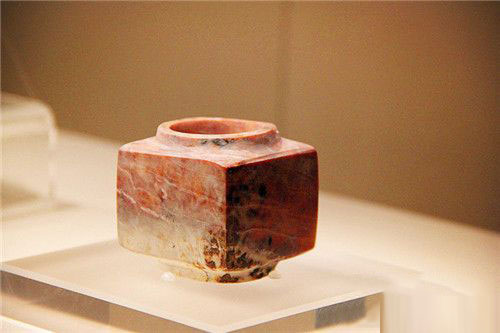In the eight-thousand-year-old jade culture process in China, the ancient jade is like a messenger from ancient times, connecting the Chinese stars in a flash. From the Central Plains to the northwest, from the lower reaches of the Yellow River to the Yangtze River Basin, the Xia Shang jade is like a starry sky, condensing all the essence of that era, reflecting the frequent regional exchanges, and also reflecting the ancient and ancient cities that have been open and inclusive since ancient times. Temperament; and the subtle traces of years of polishing reveal the fine craftsmanship of that era.
On September 24th, "Yuhui Jinsha - Xia Merchants Jade Culture Special Exhibition" was opened at the Jinsha Site Museum. More than 250 pieces of Xia Shang jadeware excavated in various regions of the country were unveiled in Chengdu, which was unearthed in the Xia and Shang period. The largest concentration of the first concentrated display. At the same time, the "International Symposium on Jade Culture in the Xia and Shang Dynasties" and the academic monograph "Jinsha Yugong I - Jade and Stone Excavation Unearthed from the Jinsha Site" were held at the same time, attracting domestic and foreign jade culture experts to gather together to focus on the latest academics of Xia Shangyu. The results reveal the latest research findings of the ancient jade jade.

The biggest event of Xia Shang jade
The word "Jade Soul" is the best interpretation of the unique position of jade in Chinese civilization. The jade articles of the Xia and Shang Dynasties, in the tradition of "the jade gods" in the Neolithic Age, created a new trend of "taking jade to rituals" and starting the two-week period of "Yu Bide", with its star-studded The distribution, the integration of the shape and the exquisite craftsmanship have set off the second peak in the history of the development of Chinese jade culture, which has had a profound impact on the development and evolution of the later jade culture.
What is the length of Xia Shangyu, which is three or four thousand years old? What kind of fashion trend did the ancients' aesthetics have at the time, and what effect did it have on cultural exchanges? In particular, Sands specially cooperated with 11 cultural and cultural units of the Institute of Archaeology of the Chinese Academy of Social Sciences, Zhengzhou Institute of Cultural Relics and Archaeology, Shaanxi History Museum and Hubei Provincial Museum to hold a special exhibition of jade culture in the Xia and Shang period, to showcase the Taosi ruins of Shanxi and the Shenmu of Shaanxi for the audience system. Shiqian Ruins and Xinhua Site, Henan Gongyi Huadizui Site, Henan Erlitou Site, Shandong Sujing Commercial Tomb, Hubei Panlongcheng Site, Henan Yinxu Site, Shandong Qianzhang Grand Cemetery, Jiangxi Xingan Dayangzhou Commercial Tomb, Sichuan The jade articles excavated from 12 important archaeological sites in the Xia and Shang dynasties, such as the Sanxingdui site and the Jinsha site, are full of exquisite beauty and jade, which reproduces the grand occasion of the interactive exchange of jade culture in the Xia and Shang dynasties.
In this exhibition, more than 250 pieces of cultural relics are subdivided into six units, from “Yuyu Tianchengâ€, “Axe Shenweiâ€, “Kuiyu Sacrificeâ€, “ç®ç’§ Dialogueâ€, “Linglong and delicate carvingâ€, “discriminating†The Ministry of Knowledge and other parts introduces what are the common types of jade and Xia Shang jade, jade crafts and decorative techniques, and interpret the cultural connotation and craftsmanship of jade articles in the Xia and Shang dynasties.

The magical charm of ancient civilization
Liaohe River Basin, Yellow River Basin, Yangtze River Basin... In the land of Shenzhou, the distribution of jade is like a starry sky, blending with each other. In the Xia and Shang dynasties, it is the peak of the frequent interaction of jade culture, which allows people to see the historical origin of the pluralistic integration of Chinese civilization.
The Sanxingdui and Jinsha sites in the Chengdu Plain are one of the most abundant and richest types of jade articles in the Xiadian period. The number of jade unearthed exceeds the total number of unearthed in the country. The ten-section jade from the Liangzhu culture in the lower reaches of the Yangtze River originates from the jade, jade and jade in the Yellow River Basin, and the ancient monks widely absorb the jade culture of other regions. The new varieties and new models of jade are not only the witness of the exchange and integration of Chinese jade culture, but also the cultural witness of the Chengdu Plain since the ancient times.
Wang Yi, director of the Jinsha Site Museum, lamented: "We have never felt the close relationship between the Sands and the Yellow River Basin and the Yangtze River Basin as it is today. It is not only an important part of the integration of Chinese civilization, but also the 'base camp' of the Central Plains culture to the southwest. 'one."
The jade has not stopped at the Chengdu Plain, which is a thousand miles away, but has continued to extend from the “transfer station†of cultural exchanges in the southwestern region: the jade fangs from the Central Plains have been imitated and copied by the ancient royal family. The change occurred, and then through the south of the Sichuan Basin to Southeast Asia; jade articles with distinctive features such as collar jade and concave jade chisel have also been unearthed in vast areas such as Vietnam and Thailand, and have become a strong evidence of cultural exchanges in different regions. The jade culture spreads to the Quartet and reaches thousands of kilometers. It can be described as "the four poles of jade flow."

Crack the password of the ancient jade jade
An amazing number of beautifully crafted jade ornaments show the important role of jade in the ancient world of witches and gods. More than 2,000 pieces of jade articles have been unearthed at the Jinsha site. The jade articles are the most abundant and most characteristic types of artifacts unearthed in the Jinsha site. These jade articles are rich in variety, diverse in color, and complex in process. Many artifacts still retain traces of production and processing, creating conditions for studying the jade crafts and handicraft technology development of the ancient Shu Kingdom, and also studying the origin of ancient Chinese jade in the southwest region. , development, and evolution provide opportunities.
How are these jade articles made? The Chengdu Institute of Cultural Relics and Archaeology, the Chengdu Jinsha Site Museum and the Chinese Archaeological Art Research Center of the Chinese University of Hong Kong jointly established the “Jinsha Site Jadeware Micro-Trace Process Research Groupâ€, using high-definition macro shooting jade to make and use traces, micro-marking process observation Compare and other methods, especially to compare the ancient jade articles with other regional cultures in China and even related artifacts in East Asia, and then reveal the modeling characteristics, craftsmanship and source characteristics of Jinsha jade.
It is worth mentioning that this Xia Shang jade special exhibition also held a seminar, from more than 40 domestic and foreign cultural research institutions, more than 80 jade culture research experts Qi Jurong City, to jointly explore the jade culture. Wang Wei, member of the Chinese Academy of Social Sciences and chairman of the Chinese Archaeological Society, is looking forward to this academic event. In his view, the original shape, color and infiltration culture of jade articles are very eye-catching, and this exhibition brings together jade articles from the Central Plains and the middle and lower reaches of the Yangtze River during the Xia and Shang dynasties. The cultural event of jade.
The participating experts were very interested in how the jade articles of the three or four thousand years ago were used for cutting and punching. The tiny details of cutting, cutting, hoeing and grinding of Jinsha jade were actually unprecedented new achievements in the study of ancient civilizations. The mystery of the jade craftsmanship has made an important contribution. Wang Wei introduced that the latest research found that the jade carving technique unearthed from the Jinsha site is unique and has its own shape. It is very likely that the jade articles were produced locally during the Xia Dynasty and exported materials and techniques to the surrounding cities. "Look at the scepter that has no substantive function and symbolizes power. The degree of radiation to the Vietnamese region is far beyond our imagination. This shows that in the late Xia Dynasty, the Jinsha and Sanxingdui cultures were highly developed, no less than the Central Plains region."
Pet Product,Dog Hooded Towel,Dog Bath Dry Towel,Microfiber Bathrobe Towel
Changshu Aijia Knitting Products , https://www.microfiber-lovejoy.com